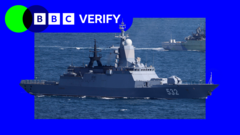Estonia’s military has dispatched a patrol boat to safeguard its power connection with Finland, amid allegations of Russian sabotage on undersea cables. NATO announces plans to bolster its footprint in the Baltic region to enhance security cooperation.**
NATO Strengthens Baltic Defenses Following Sabotage of Undersea Cables**

NATO Strengthens Baltic Defenses Following Sabotage of Undersea Cables**
Call for increased military presence in response to recent attacks on critical infrastructure in the Gulf of Finland.**
NATO has announced plans to ramp up its military presence in the Baltic Sea in light of recent tensions concerning undersea cable security. Following accusations of sabotage against critical infrastructure, specifically the Estlink 1 and Estlink 2 power cables, Estonia has deployed the patrol boat Raju to monitor the protection of its vital energy link with Finland. This strategic move comes after allegations that the Russian-registered vessel, Eagle S, caused damage to the Estlink 2 cable, significantly compromising Estonia's energy supply.
In response, the European Union has labeled the Eagle S as part of "Russia's shadow fleet," emphasizing the ongoing threat to critical facilities across the region. Estonia's Defence Minister, Hanno Pevkur, confirmed that the Raju is on high alert to maintain the integrity of the power connection, adding that collaboration with Finland would enhance their security measures.
NATO Secretary General Mark Rutte shared on social media that he has engaged with Finnish President Alexander Stubb about the situation, affirming the alliance's commitment to increasing its military presence in the Baltic area. Both Finland and Estonia, members of NATO, are prepared to implement Article 4 of the NATO Treaty to explore reinforcements amid rising concerns of threats to member states.
Estonian Prime Minister Kristen Michal has indicated a desire for NATO support in the form of additional naval resources, expressing the need for deterrent capabilities in case of ongoing threats. The recent incidents represent a troubling trend; Estonia’s power supply has been critically impacted, with estimates from Finland's Fingrid suggesting significant downtime for cable repairs, potentially lasting until mid-2025.
The dangers posed by alleged sabotage extend beyond the Estlink cables; recent incidents have included the severing of data cables between Sweden and Lithuania and the disruption of an undersea gas pipeline. Additionally, the shadowy activities of vessels such as the Yi Peng 3 and the Eagle S raise alarms about the evolving maritime threats faced by European nations, prompting calls for a unified response from the EU to tackle these security issues.
In light of these developments, Estonia reassures its citizens that backup power systems are in place to ensure continuous electricity supply, albeit recognizing the challenges in securing extensive maritime areas. The collaborative efforts of NATO member states and European institutions are now more crucial than ever for safeguarding against these emerging maritime threats and instilling confidence in regional security.




















